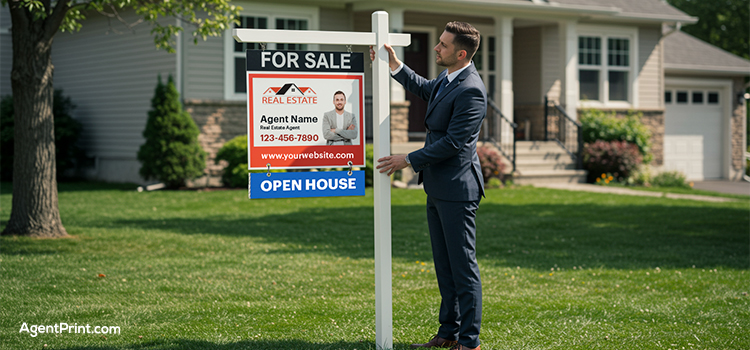In the intricate world of real estate, both virtual and physical manifestations play crucial roles in effective marketing. The importance of eye-catching marketing materials, like real estate signs, including yard signs, remains a timeless essential component even as digital platforms grow. However, the key factor here is the best techniques for installing real estate signs for utmost efficacy.
Although AgentPrint.com does not provide installation services, to show our appreciation to our loyal customers, we prepared this DIY guide that explores methods to install different types of real estate signs. This guide includes practical installation methods for feather flags, ‘For Sale’ signs, sign riders, and directional signs.
The Importance of Installing Real Estate Signs Correctly
It is not enough to simply install a sign. It is up to real estate agents to figure out how to put it right. First of all, the location of the sign is important. It must be in an easily visible location that attracts the highest number of people. The sign must also have a stylish appearance and present all relevant information in an eye-catching manner.
Additionally, the sign must be properly positioned to remain safe and visible in all weather conditions. In other words, every step of the process—from creating the sign to installing it—must be done carefully. Never undervalue the impact of a well-made and strategically placed real estate sign. Let’s explore the useful ways to install different types of real estate signs.
Installing Different Types of Real Estate Signs
Whether it’s an A-frame sign, a feather flag, or a directional sign, each has its unique significance and method of installation. They serve different purposes, such as announcing the property for sale or guiding potential buyers to the property. So, understanding these different types of signs and learning how to install them is vital for successful real estate marketing. Let’s dive right into the installation of real estate signs.

How to Install Feather Flags for Real Estate?
Feather flags are designed to catch the eye and create a bold, distinct presence. Placement in spaces with limited space is made possible by their narrow and vertical shape, and their impact can be increased by using multiple flags. The long-term use and visibility of feather flags are guaranteed by their sturdy construction and ability to tolerate a range of weather conditions. Here’s how to install them:
- Pole Assembly: Start by connecting the pole sections. Ascend from the thickest at the base to the thinnest thickness at the top.
- Attach the Fabric to the Flagpole: Now, you should attach the fabric to the flagpole. Slide the pole from the top through a pocket sewn into the flag. Ensure the flag is right-side-up and that the pole is fully inserted into the pocket.
- Insert the Ground Stake Firmly: Locate an appropriate spot for your feather flag. It should be visible from a distance and free of obstructions. Hammer the ground stake into the ground, leaving the top exposed to insert the flagpole.
- Secure the Pole and Adjust Alignment: Place the assembled flagpole onto the ground stake. Be cautious as you secure the pole, ensuring it is vertically aligned for maximum visibility and stability.
Read More: Tips for Effective Real Estate Sign Placement in Canada
Installing Metal Posts for ‘For Sale’ Real Estate Signs

These are traditional yet powerful signs in the real estate market. These signs usually feature metal posts, enabling them to withstand various weather conditions. You can highlight your property and draw in potential buyers by putting up a For Sale sign. Regardless of your background—homeowner or real estate agent—you must follow important steps in installing For Sale signs to leave a lasting impression. Here’s a step-by-step guide to installing these custom-made signs:
- Pick a High-Visibility Location: Choose an area that is easily visible to onlookers and has a clear line of sight. Watch out—the sign shouldn’t block access or views.
- Digging the hole: Dig the ground in the desirable spot, and create a hole about one-third of the height of the post for stability.
- Installing the post: Place the post into the hole and ensure it is lined up correctly. Fill the hole with soil or rocks, or set it in concrete to guarantee maximum stability.
- Securing the sign: Secure the sign to the post with sturdy zip ties.
How to Install Real Estate Sign Riders?

Usually affixed to a larger sign, sign riders are tiny, supplemental signs that are frequently used in real estate to highlight more details about a property. They can be used to draw attention to particular features, announce open houses, or show the listing’s current status. Here’s the best method for sign rider installation:
- Start Preparing the tools: Depending on the type of sign and mounting technique, make sure you have the sign rider, the main sign or post, and the necessary fasteners (zip ties, push pins, or other hardware). Locate the rider’s attachment point on the main sign or post. Coordinate the rider’s pre-drilled holes with the matching holes on the main sign or post.
- Securing the Rider: When using push pins, place one half of the pin through the rider’s hole and the other half on the side opposite the main sign or post. Then, press the two halves together to secure. If a metal post has top pins, slide the rider onto the pins and lock it firmly in place.
- Check the Attachments: The rider should be level and in line with the main post or sign. To increase your sign’s durability, make sure all of the fasteners are tight.
Installing Directional Signs for Real Estate Open Houses

In the real estate industry, a directional sign is a sign that directs prospective tenants or buyers to a particular property or open house. These signs are usually found at intersections or along roads. For listings that are in less obvious places or that are hosting open houses, these signs are essential for drawing attention to them. Here’s how to install them:
- Find the Best Place: Install the sign in a way that makes it easy to see from the sidewalk and the street. The sign’s exposure will be increased in areas with high traffic volumes. Verify whether there are any local regulations governing the placement of signs, particularly those regarding size, height, and proximity to the road.
- Determine the Route: First, drive the path to your property, noting the best spots to place the signs. Then, spot the proper place to easily guide the viewers from the signs to the property.
- Install Signs: A hole that is roughly one-third the height of the post should be made using a post-hole digger. In regions with strong winds or high traffic, make sure the hole is deep enough to support the post adequately. Before filling the hole, use a level to ensure the post is perfectly vertical.
- Position, Secure, and Final Check: Make sure the post is plumb before inserting it into the hole. For added stability, use concrete or fill the hole with rocks or soil. Before affixing the sign, let the concrete cure completely if using it. To secure the sign to the post, use screws, sturdy zip ties, or other suitable fasteners. Make sure the sign points in the direction of traffic or the path that leads to the property.
Final Words
There is no question about the effectiveness of real estate signs as visual sales pitches. They pique interest, entice prospective homeowners, and covertly broadcast important real estate information. Gaining a working understanding of how to install signs correctly is the first step for real estate professionals looking to increase property visibility, build relationships with potential buyers, and close deals.
The above-mentioned tips will help you in installing real estate signs properly. However, for printing high-quality real estate signs or other marketing materials, AgentPrint.com has an expert team to help you achieve your marketing goals. You can consult with our professional team and finalize your order for all types of real estate signs and their installation accessories.
